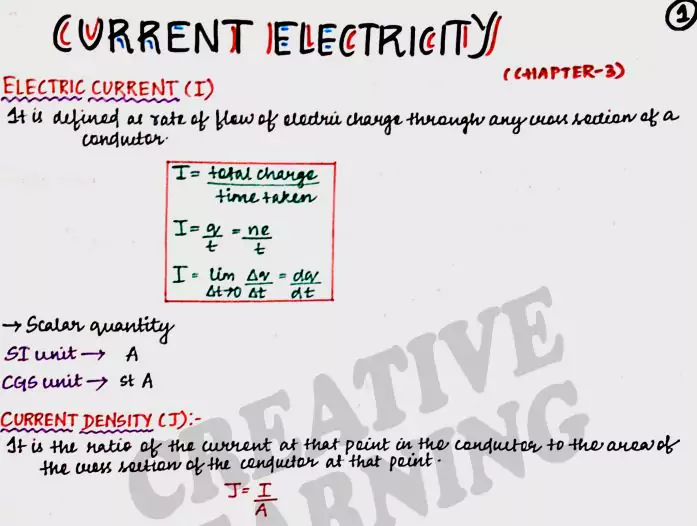‘Current Electricity Class 12 ‘ PDF Quick download link is given at the bottom of this article. You can see the PDF demo, size of the PDF, page numbers, and direct download Free PDF of ‘NCERT Solutions For Class 12 Physics’ using the download button.
NCERT Class 12 New Books For Physics PDF Free Download

Current-Electricity
INTRODUCTION
In Chapter 1, all charges whether free or bound were considered to be at rest. Charges in motion constitute an electric current. Such currents occur naturally in many situations.
Lightning is one such phenomenon in which charges flow from the clouds to the earth through the atmosphere, sometimes with disastrous results.
The flow of charges in lightning is not steady, but in our everyday life, we see many devices where charges flow in a steady manner, like water flowing smoothly in a river.
A torch and a cell-driven clock are examples of such devices. In the present chapter, we shall study some of the basic laws concerning steady electric currents.
ELECTRIC CURRENT
Imagine a small area held normal to the direction of the flow of charges. Both the positive and the negative charges may flow forward and backward across the area.
In a given time interval t, let q, be the net amount (Le.. forward minus backward) of positive charge that flows in the forward direction across the area. Similarly, let q be the net amount of negative charge flowing across the area in the forward direction.
The net amount of charge flowing across the area in the forward direction in the time interval t, then, is q-q-q. This is proportional to t for steady current and the quotient is defined to be the current across the area in the forward direction.
(If it turns out to be a negative number, it implies a current in the backward direction.)
Currents are not always steady and hence more generally, we define the current as follows. Let AQ be the net charge flowing across a cross-section of a conductor during the time interval At [i.e., between times t and (t+A].
Then, the current at time t across the cross-section of the conductor is defined as the value of the ratio of AQ to At in the limit of Attending to zero,
ΔΟ I(t)= lim A-40 At
In SI units, the unit of current is ampere. An ampere is defined through the magnetic effects of currents that we will study in the following chapter.
An ampere is typically the order of magnitude of currents in domestic appliances. An average of lightning carries currents of the order of tens of thousands of amperes and at the other extreme, currents in our nerves are in microamperes.
Electric Currents In Conductors
An electric charge will experience a force if an electric field is applied. If it is free to move, it will thus move contributing to a current.
In nature, free-charged particles do exist in the upper strata of the atmosphere called the Ionosphere.
However. In atoms and molecules, the negatively charged electrons and the positively charged nuclei are bound to each other and are thus not free to move.
The bulk matter is made up of many molecules, a gram of water, for example, contains approximately 10 molecules.
These molecules are so closely packed that the electrons are no longer attached to individual nuclei. In some materials, the electrons will still be bound.
1.e., they will not accelerate even if an electric field is applied. In other materials, notably metals, some of the electrons are practically free to move within the bulk material.
These materials, generally called conductors, develop electric currents in them when an electric field is applied.
If we consider solid conductors, then of course the atoms are tightly bound to each other so that the current is carried by the negatively charged electrons.
There are, however, other types of conductors like electrolytic solutions where positive and negative charges both can move.
In our discussions, we will focus only on solid conductors so that the current is carried by the negatively charged electrons in the background of fixed positive ions.
Consider first the case when no electric field is present. The electrons will be moving due to thermal motion during which they collide with the fixed ions.
An electron colliding with a lon emerges at the same speed as before the collision. However, the direction of Its velocity after the collision is completely random.
At a given time, there is no preferential direction for the velocities of the electrons. Thus on average.
| Author | – |
| Language | English |
| No. of Pages | 18 |
| PDF Size | 5 MB |
| Category | Education |
| Source/Credits | drive.google.com |
Workshop Calculation And Science 1st Year Book PDF
Lesson Planning in Primary and Secondary PDF
Workshop Calculation And Science 1st Year Book PDF
ICSE Boards Books History Textbook PDF
What is Public Policy: Meaning And Nature PDF
पीएच मान | PH Man List PDF In Hindi
NCERT Class 12 New Books For Physics PDF Free Download
